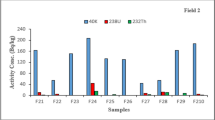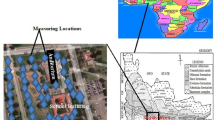Abstract
This research is monitoring and exploring the evaluation of dose levels and determination of the specific activity of natural and artificial radionuclides in different rice types consumed in Basrah/Iraq. This study was the first radiological study focused on the comparison of dose rates and radiation risk indices measured using thermoluminescence technique and SAM940-2G. The activity determination of selected radionuclides was carried out by using SAM940-2G running remote applications and performing quantitative analysis. The specific activity values of U-238, Th-232, K-40 and Cs-137 ranged as (0.051 ± 0.011–0.529 ± 0.003) Bq/kg with an average (0.239 ± 0.161) Bq/kg, (0.006 ± 0.003–1.225 ± 0.002) Bq/kg with an average (0.293 ± 0.398) Bq/kg, (31.763 ± 0.001–437.233 ± 0.0004) Bq/kg with an average (157.807 ± 147.194) Bq/kg and (0.119 ± 0.004–0.784 ± 0.002) Bq/kg with an average (0.444 ± 0.235) Bq/kg, respectively. Several hazard indices have been calculated for all rice samples involved in this study. All results have agreed with those described in previously published studies, and all these obtained results have been identified the radiation to be below the worldwide limit values. Thus, consumed rice brands in Basrah governorate are radiologically safe, in particular R2 sample which is classified as the brand safest from radiation risk.


Similar content being viewed by others
References
Ababneh ZQ, Alyassin AM, Aljarrah KM, Ababneh AM (2009) Measurement of natural and artificial radioactivity in powdered milk consumed in Jordan and estimates of the corresponding annual effective dose Radiation Protection Dosimetry:ncp260 https://doi.org/10.1093/rpd/ncp260
Abojassim AA (2017) Annual effective dose of gamma emitters in infants, children and adults for frozen chicken samples consumed in Iraq. Curr Pediatr Res 21
Abojassim AA, Al-Gazaly HH, Kadhim SH (2014) Estimated the radiation hazard indices and ingestion effective dose in wheat flour samples of Iraq markets. Int J Food Contam 1:6. https://doi.org/10.1186/s40550-014-0006-7
Abojassim AA, Hady HN, Mohammed ZB (2016) Natural radioactivity levels in some vegetables and fruits commonly used in Najaf Governorate, Iraq. J Bioenergy Food Sci 3:113–123. https://doi.org/10.18067/jbfs.v3i3.108
Abul-Hail RC (2009) Radiation dosimetry of food salt and its possible use as a TL dosimeter. University of Basrah
Al-Hamidawi A (2014) Assessment of radiation hazard indices and excess life time cancer risk due to dust storm for Al-Najaf, Iraq. WSEAS Trans Environ Dev 10:312. https://doi.org/10.17265/2159-5348/2015.02.008
Alharbi W, Alamoudi ZM (2017) Radiological hazard of coffee to humans: a comparative study of Arabian and Turkish coffees. Afr J Agric Res 12:327–341. https://doi.org/10.5897/ajar2016.12031
Al-Hassan AA, Abdel-salam AM, El-Taher A (2014) Assessment of natural radioactivity levels and heavy metals in different types of rice consumed in Qassim. Saudi Arabia Life Sci J 11:829–836
Alrefae T, Nageswaran TN (2013) Radioactivity of long lived gamma emitters in rice consumed in Kuwait. J Assoc Arab Univ Basic Appl Sci 13:24–27. https://doi.org/10.1016/j.jaubas.2012.07.005
Al-Zahrani J (2016) Natural radioactivity and heavy metals measurement in rice and flour consumed by the inhabitants in Saudi Arabia. Adv J Food Sci Technol 12:698–704. https://doi.org/10.19026/ajfst.12.3331
Azorín Nieto J (2004) Thermoluminescence dosimetry (TLD) and its application in medical physics. In: AIP conference proceedings, vol 1. AIP, pp 20–27. https://doi.org/10.1063/1.1811814
Cember H, Johnson TE (2009) Introduction to health physics. https://doi.org/10.1063/1.2916417
Furetta C (2010) Handbook of thermoluminescence, 2nd edn. World Scientific Publishing Co. Pte. Ltd. https://doi.org/10.1142/7187
Hemada H, Salih I (2009) Radioactivity levels of basic foodstuffs and dose estimates in Sudan. LAP LAMBERT Academic Publishing, Sudan
Hosseni T, Fathi AA, Barati H, Karimi M (2006) Assessment of radionuclides in imported foodstuffs in Iran. IranJRadiatRes 4:159–164
International Atomic Energy Agency (1989) Measurement of radionuclides in food and the environment International Atomic Energy Agency (IAEA), Vienna. https://doi.org/10.18356/c316b91d-en
International Atomic Energy Agency (2003) Guidelines for radioelement maping using gamma ray spectrometry data. IAEA-TECDOC-1363, Vienna, Austria. https://doi.org/10.18356/896e31a6-en
International Commission on Radiological Protection (2007) ICRP publication 103 Ann ICRP 37:2
Karki S, Poudel NS, Bhusal G, Simkhada S, Regmi BR, Adhikari B, Poudel S (2018) Growth parameter and yield attributes of rice (Oryza sativa) as influenced by different combination of nitrogen sources. World 6:58–64
Knoll GF (2000) Radiation detection and measurement, 3rd edn. Wiley, Hoboken
Mejdahl V (1969) Thermoluminescence dating of ancient Danish ceramics. Archaeometry 11:99–104. https://doi.org/10.1111/j.1475-4754.1969.tb00632.x
Mlwilo N, Mohammed N, Spyrou NM (2007) Radioactivity levels of staple foodstuffs and dose estimates for most of the Tanzanian population. J Radiol Prot 27:471. https://doi.org/10.1088/0952-4746/27/4/008
Najam LA, Tawfiq NF, Kitah FH (2013) Measurement of natural radioactivity in building materials used in IRAQ. Aust J Basic Appl Sci 7:56–66
Omeje M et al (2018) Natural radioactivity concentrations of 226Ra, 232Th, and 40 K in commercial building materials and their lifetime cancer risk assessment in dwellers. Hum Ecol Risk Assess Int J Adv Res. https://doi.org/10.1080/10807039.2018.1438171
Poschl M, Nollet LML (2006) Radionuclide concentrations in food and the environment. CRC Press. https://doi.org/10.1201/9781420019278
Saeed M, Wahab N, Hossain I, Ahmed R, Abdullah H, Ramli A, Tahir BA (2011) Measuring radioactivity level in various types of rice using hyper pure germanium (HPGe) detector. Int J Phys Sci 6:7335–7340. https://doi.org/10.5897/ijps11.1345
Salih NF (2018) Determination of natural radioactivity and radiological hazards of 226Ra, 232Th, and 40 K in the grains available at Penang markets, Malaysia, using high-purity germanium detector ARO. Sci J Koya Univ 6:71–77. https://doi.org/10.14500/aro.10327
Sobiech-Matura K, Máté B, Altzitzoglou T (2017) Radioactivity monitoring in foodstuff and drinking water-An overview of performance of EU laboratories based on interlaboratory comparisons. Food Control 72:225–231. https://doi.org/10.1016/j.foodcont.2016.04.043
Taskin H, Karavus M, Ay P, Topuzoglu A, Hidiroglu S, Karahan G (2009) Radionuclide concentrations in soil and lifetime cancer risk due to gamma radioactivity in Kirklareli, Turkey. J Environ Radioact 100:49–53. https://doi.org/10.1016/j.jenvrad.2008.10.012
The Iraqi Ministry of Trade (2018) Ration card system (RCS). http://www.mot.gov.iq/
United Nations Scientific Committee on the Effects of Atomic Radiation (2000) Sources and effects of ionizing radiation vol 1. UNSCEAR 2000 report. United Nations Sales Publication, United Nations, New York
UNSCEAR (2010) Sources and effects of ionizing radiation UNSCEAR 2008 Report to the general assembly with scientific annexes vol I. UNSCEAR 2008 report. United Nations Sales Publication, United Nations, New York
Yadav P, Garg V, Singh B, Pulhani V, Mor S (2017) Transfer factors and effective dose evaluation due to natural radioactivity in staple food grains from the vicinity of proposed nuclear power plant. Expo Health 10:27–39. https://doi.org/10.1007/s12403-017-0243-0
Acknowledgements
The authors would like to acknowledge all those contributed in declaring this issue. Special thanks to the staff of the Physics Department at College of Education for Pure Sciences, University of Basrah.
Author information
Authors and Affiliations
Corresponding author
Ethics declarations
Conflict of interest
The authors declare that they have no conflict of interest.
Additional information
Editorial responsibility: Shahid Hussain.
Rights and permissions
About this article
Cite this article
Alhiall, R.A., Alsalihi, AA. Radiation dosimetry of some rice types consumed in Basrah Governorate/Iraq by using thermoluminescence technique and SAM940-2G. Int. J. Environ. Sci. Technol. 16, 6579–6586 (2019). https://doi.org/10.1007/s13762-018-2176-y
Received:
Revised:
Accepted:
Published:
Issue Date:
DOI: https://doi.org/10.1007/s13762-018-2176-y




